

Compact Muon Solenoid
LHC, CERN
| CMS-PAS-FTR-18-010 | ||
| Search for supersymmetry with direct stau production at the HL-LHC with the CMS Phase-2 detector | ||
| CMS Collaboration | ||
| November 2018 | ||
| Abstract: A search for the direct production of τ sleptons (˜τ) is developed assuming 3000 fb−1 of proton-proton collision data produced by the HL-LHC at a center-of-mass energy of 14 TeV. Three final states are investigated: two τ leptons decaying hadronically, and one τ lepton decaying hadronically and the other one decaying to a muon or electron and neutrinos. The analysis is performed using the Delphes simulation of the CMS Phase-2 detector where the object reconstruction performance is tuned to the one achieved with CMS Phase-2 full simulation. In the mass-degenerate production scenario, ˜τ masses are excluded below 650 GeV, with the discovery contour of ˜τ masses reaching up to 470 GeV. | ||
| Links: CDS record (PDF) ; CADI line (restricted) ; | ||
| Figures & Tables | Summary | Additional Figures | References | CMS Publications |
|---|
| Figures | |

png pdf |
Figure 1:
Diagram for the ˜τ pair production. |

png pdf |
Figure 2:
The main search variables for the τhτh analysis, (left) ΣMT and (right) MT2, both after the baseline selection. Scaled signal yields for direct ˜τ production with the mass-degenerate cross section are shown for three separate scenarios of ˜τ and LSP masses. All processes containing top quarks, i.e. t¯t, single top quark, and t¯t+X production are combined and referred to "Top Quark" in the figure, while "Other SM" corresponds to background processes with a low number of events that are combined, diboson and triboson production. |

png pdf |
Figure 2-a:
Search variable ΣMT for the τhτh analysis, after the baseline selection. Scaled signal yields for direct ˜τ production with the mass-degenerate cross section are shown for three separate scenarios of ˜τ and LSP masses. All processes containing top quarks, i.e. t¯t, single top quark, and t¯t+X production are combined and referred to "Top Quark" in the figure, while "Other SM" corresponds to background processes with a low number of events that are combined, diboson and triboson production. |
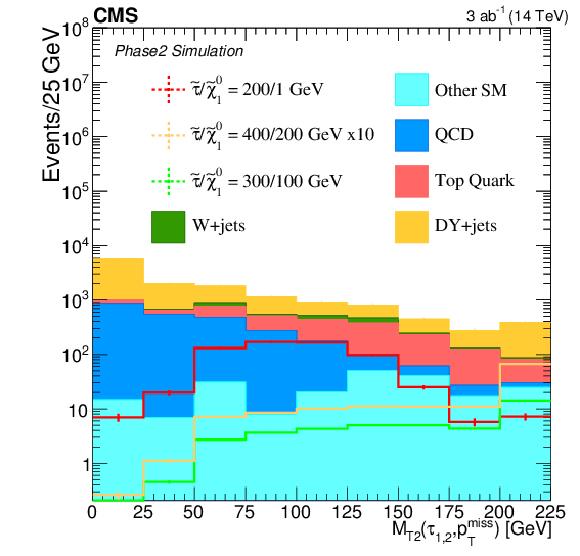
png pdf |
Figure 2-b:
Search variable MT2 for the τhτh analysis, after the baseline selection. Scaled signal yields for direct ˜τ production with the mass-degenerate cross section are shown for three separate scenarios of ˜τ and LSP masses. All processes containing top quarks, i.e. t¯t, single top quark, and t¯t+X production are combined and referred to "Top Quark" in the figure, while "Other SM" corresponds to background processes with a low number of events that are combined, diboson and triboson production. |
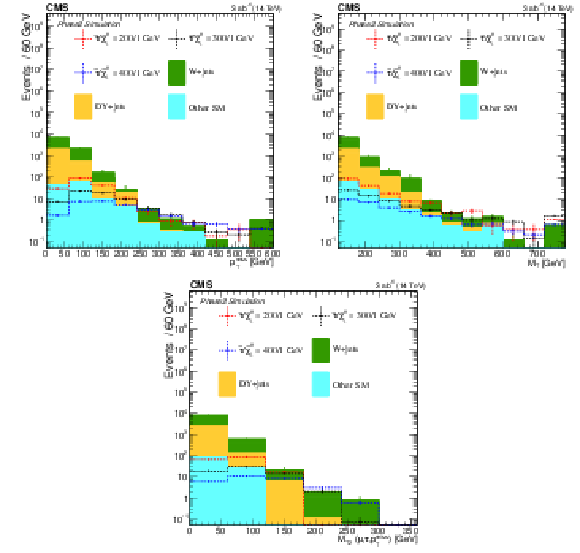
png pdf |
Figure 3:
The variables used to determine the search regions in the eτh analysis after the baseline selection: (upper left) the pTmiss distribution, (upper right) the MT distribution, and (lower) the MT2 distribution using pTmiss after the baseline selection. "Other SM" refers to processes with a low number of events after the baseline selection and includes diboson, triboson, t¯t and single top quark production. |
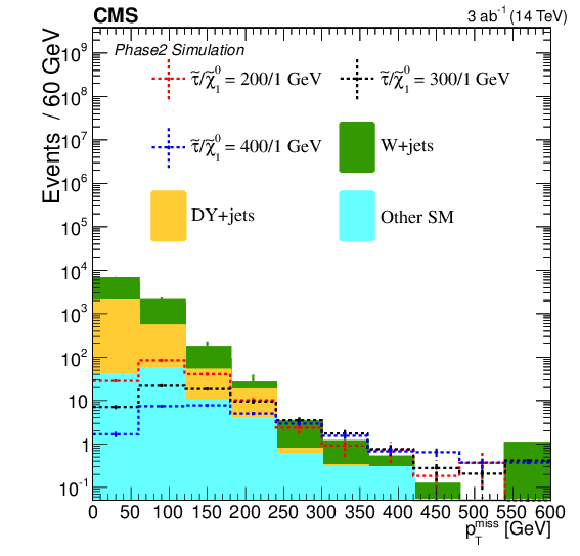
png pdf |
Figure 3-a:
pTmiss distribution in the eτh analysis after the baseline selection. "Other SM" refers to processes with a low number of events after the baseline selection and includes diboson, triboson, t¯t and single top quark production. |
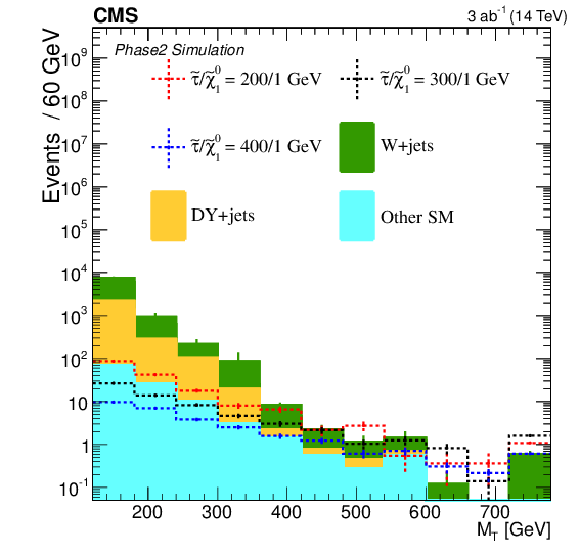
png pdf |
Figure 3-b:
MT distribution in the eτh analysis after the baseline selection. "Other SM" refers to processes with a low number of events after the baseline selection and includes diboson, triboson, t¯t and single top quark production. |
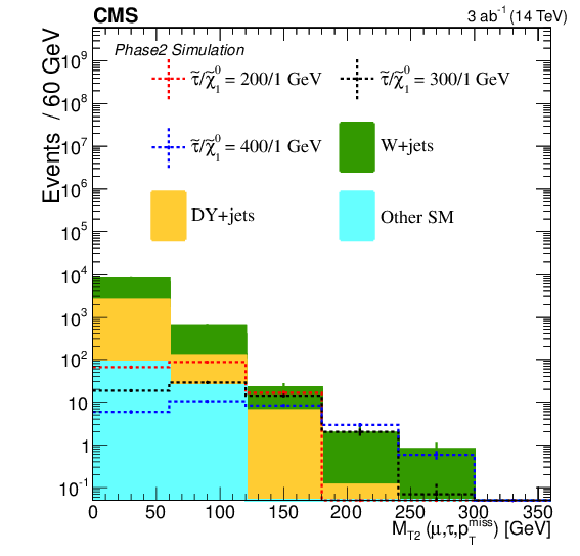
png pdf |
Figure 3-c:
MT2 distribution using pTmiss in the eτh analysis after the baseline selection. "Other SM" refers to processes with a low number of events after the baseline selection and includes diboson, triboson, t¯t and single top quark production. |

png pdf |
Figure 4:
The variables used to determine the search regions in the μτh analysis after the baseline selection: (upper left) the pTmiss distribution, (upper right) the MT distribution, and (lower) the MT2 distribution using pTmiss after the baseline selection. "Other SM" refers to processes with a low number of events after the baseline selection and includes diboson, triboson, t¯t and single top quark production. |
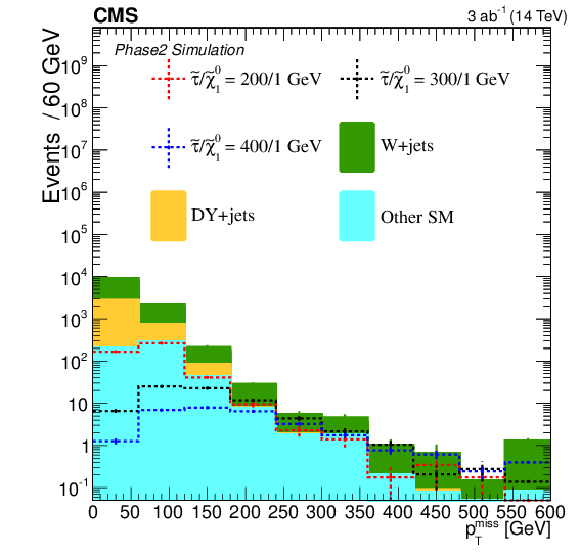
png pdf |
Figure 4-a:
pTmiss distribution in the μτh analysis after the baseline selection. "Other SM" refers to processes with a low number of events after the baseline selection and includes diboson, triboson, t¯t and single top quark production. |
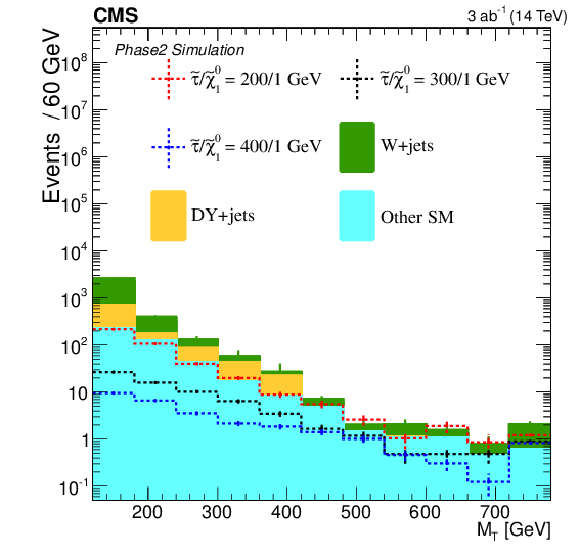
png pdf |
Figure 4-b:
MT distribution in the μτh analysis after the baseline selection. "Other SM" refers to processes with a low number of events after the baseline selection and includes diboson, triboson, t¯t and single top quark production. |
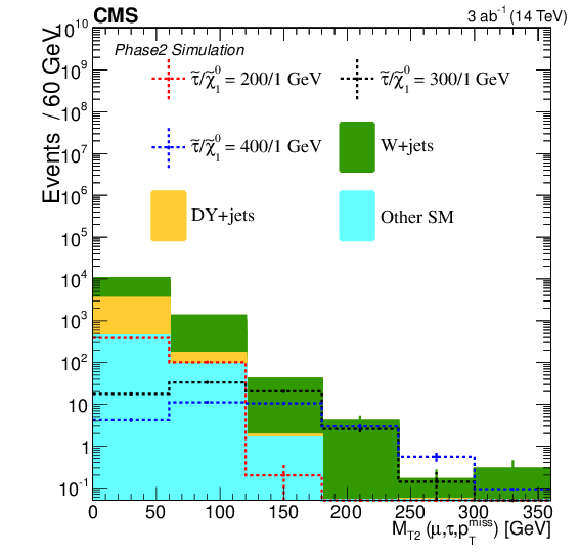
png pdf |
Figure 4-c:
MT2 distribution using pTmiss in the μτh analysis after the baseline selection. "Other SM" refers to processes with a low number of events after the baseline selection and includes diboson, triboson, t¯t and single top quark production. |

png pdf |
Figure 5:
The expected upper limits at the 95% CL and the 5σ discovery potential for the combination of the results of the τhτh and ℓτh channels. |
| Tables | |

png pdf |
Table 1:
Summary of object selection requirements for the analysis. |

png pdf |
Table 2:
Summary of the baseline selection requirements in each final state. |

png pdf |
Table 3:
Definition of the search regions (SR) used in the τhτh analysis. Signal depleted bins (low ΣMT, high MT2) are omitted. The full list of bins and background yields is presented in Table 6. |

png pdf |
Table 4:
Search region requirements in the ℓτh analysis. |
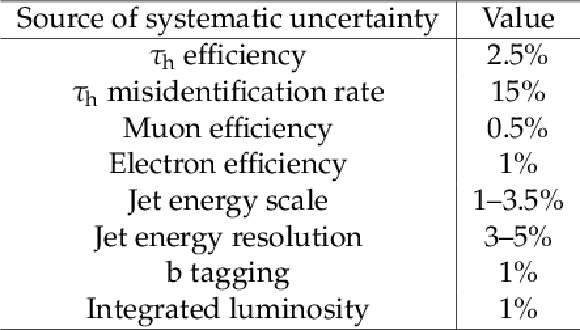
png pdf |
Table 5:
Summary of the experimental systematic uncertainties. |

png pdf |
Table 6:
Signal region yields for for background and signal simulation in the τhτh channel. The three rightmost columns show the signal predictions in the degenerate scenario, for masses given in the form of (m˜τ/m~chi01) in GeV. |

png pdf |
Table 7:
Signal region yields for background and signal simulation in the eτh channel. The three rightmost columns show the signal predictions in the degenerate scenario, for masses given in the form of (m˜τ/m~chi01) in GeV. |

png pdf |
Table 8:
Signal region yields for background and signal simulation in the μτh channel. The three rightmost columns show the signal predictions in the degenerate scenario, for masses given in the form of (m˜τ/m~chi01) in GeV. |
| Summary |
| A search for the direct production of τ sleptons has been presented, assuming 3000 fb−1 of proton-proton collision data produced by the HL-LHC at a center-of-mass energy of 14 TeV. Expected limits have been calculated for the final states that contain either two hadronically decaying τ leptons and missing transverse momentum, or one hadronically decaying τ lepton and one τ decaying to a muon or electron and neutrinos. The analysis is performed using the Delphes simulation of the CMS Phase-2 detector where the object reconstruction performance is tuned to the one achieved with CMS Phase-2 full simulation. In mass-degenerate scenarios, degenerate production of τ sleptons are excluded up to 650 GeV with the discovery contour reaching up to 470 GeV for a massless lightest neutralino. |
| Additional Figures | |

png pdf |
Additional Figure 1:
The main search variables for the τhτh analysis, ΣMT, after the baseline selection using object-based pTmiss, defined as the negative vector sum of the transverse momentum of all candidate objects in the event (candidate leptons and jets as defined in the main body of the document). Scaled signal yields for direct ˜τ production with the mass-degenerate cross section are shown for three separate scenarios of ˜τ and LSP masses. All processes containing top quarks, i.e. t¯t, single top and t¯t+X production are combined and referred to "Top Quark" in the figure, while "Other SM" corresponds to background processes with a low number of events that are combined, diboson and triboson production. |

png pdf |
Additional Figure 2:
The main search variables for the τhτh analysis, MT2, after the baseline selection using object-based pTmiss, defined as the negative vector sum of the transverse momentum of all candidate objects in the event (candidate leptons and jets as defined in the main body of the document). Scaled signal yields for direct ˜τ production with the mass-degenerate cross section are shown for three separate scenarios of ˜τ and LSP masses. All processes containing top quarks, i.e. t¯t, single top and t¯t+X production are combined and referred to "Top Quark" in the figure, while "Other SM" corresponds to background processes with a low number of events that are combined, diboson and triboson production. |

png pdf |
Additional Figure 3:
The variables used to determine the search regions in the eτh analysis after the baseline selection: the pTmiss distribution using object-based pTmiss (defined as the negative vector sum of the transverse momentum of all candidate objects in the event (candidate leptons and jets as defined in the main body of the document)) after the baseline selection. "Other SM" refers to processes with a low number of events after the baseline selection and includes diboson, triboson, t¯t and single top production. |

png pdf |
Additional Figure 4:
The variables used to determine the search regions in the eτh analysis after the baseline selection: the MT distribution using object-based pTmiss (defined as the negative vector sum of the transverse momentum of all candidate objects in the event (candidate leptons and jets as defined in the main body of the document)) after the baseline selection. "Other SM" refers to processes with a low number of events after the baseline selection and includes diboson, triboson, t¯t and single top production. |
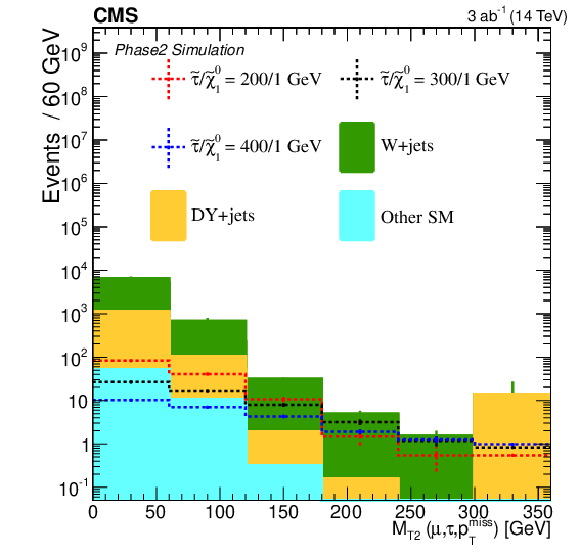
png pdf |
Additional Figure 5:
The variables used to determine the search regions in the eτh analysis after the baseline selection: the MT2 distribution using object-based pTmiss (defined as the negative vector sum of the transverse momentum of all candidate objects in the event (candidate leptons and jets as defined in the main body of the document)) after the baseline selection. "Other SM" refers to processes with a low number of events after the baseline selection and includes diboson, triboson, t¯t and single top production. |

png pdf |
Additional Figure 6:
The variables used to determine the search regions in the μτh analysis after the baseline selection: the pTmiss distribution using object-based pTmiss (defined as the negative vector sum of the transverse momentum of all candidate objects in the event (candidate leptons and jets as defined in the main body of the document)) after the baseline selection. "Other SM" refers to processes with a low number of events after the baseline selection and includes diboson, triboson, t¯t and single top production. |

png pdf |
Additional Figure 7:
The variables used to determine the search regions in the μτh analysis after the baseline selection: the MT distribution, and (lower) using object-based pTmiss (defined as the negative vector sum of the transverse momentum of all candidate objects in the event (candidate leptons and jets as defined in the main body of the document)) after the baseline selection. "Other SM" refers to processes with a low number of events after the baseline selection and includes diboson, triboson, t¯t and single top production. |
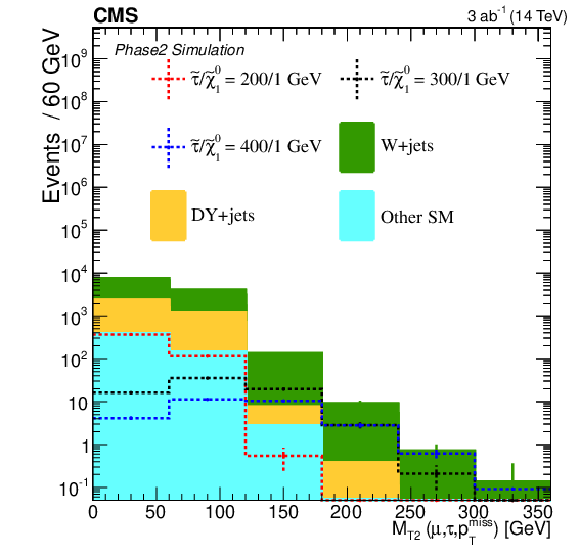
png pdf |
Additional Figure 8:
The variables used to determine the search regions in the μτh analysis after the baseline selection: the MT2 distribution using object-based pTmiss (defined as the negative vector sum of the transverse momentum of all candidate objects in the event (candidate leptons and jets as defined in the main body of the document)) after the baseline selection. "Other SM" refers to processes with a low number of events after the baseline selection and includes diboson, triboson, t¯t and single top production. |

png pdf |
Additional Figure 9:
The expected upper limits at the 95% CL and the 5σ discovery potential for the combination of the results of the τhτh and ℓτh channels using object-based pTmiss, defined as the negative vector sum of the transverse momentum of all candidate objects in the event (candidate leptons and jets as defined in the main body of the document). |

png pdf |
Additional Figure 10:
The same as Fig. 5 from the plain text but with different style. |
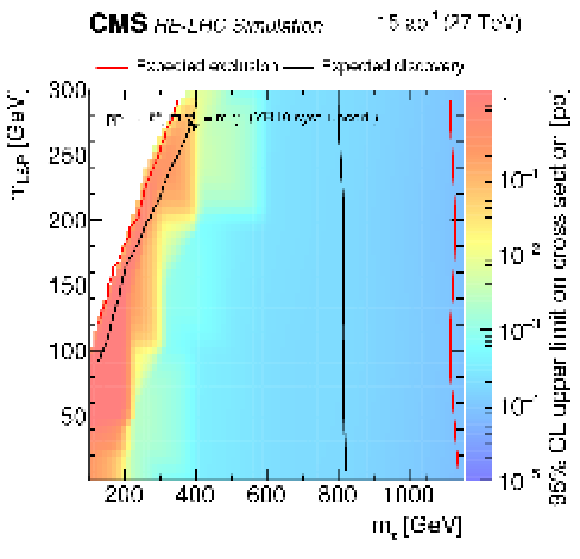
png pdf |
Additional Figure 11:
Projection of the HL-LHC 5σ discovery contours and expected 95%CL exclusion contours for the combination of the τhτh and ℓτh channels for a center-of-mass energy of 27 TeV and an integrated luminosity of 15 ab−1 (HE-LHC). Except for the cross sections and the integrated luminosity, the HL-LHC analysis was not modified. Results are presented for m˜χ01< 300 GeV. |
| References | ||||
| 1 | P. Ramond | Dual theory for free fermions | PRD 3 (1971) 2415 | |
| 2 | Y. A. Gol'fand and E. P. Likhtman | Extension of the algebra of Poincare group generators and violation of P invariance | JEPTL 13 (1971)323 | |
| 3 | A. Neveu and J. H. Schwarz | Factorizable dual model of pions | NPB 31 (1971) 86 | |
| 4 | D. V. Volkov and V. P. Akulov | Possible universal neutrino interaction | JEPTL 16 (1972)438 | |
| 5 | J. Wess and B. Zumino | A Lagrangian model invariant under supergauge transformations | PLB 49 (1974) 52 | |
| 6 | J. Wess and B. Zumino | Supergauge transformations in four dimensions | NPB 70 (1974) 39 | |
| 7 | P. Fayet | Supergauge invariant extension of the Higgs mechanism and a model for the electron and its neutrino | NPB 90 (1975) 104 | |
| 8 | H. P. Nilles | Supersymmetry, supergravity and particle physics | Phys. Rep. 110 (1984) 1 | |
| 9 | G. 't Hooft | Naturalness, chiral symmetry, and spontaneous chiral symmetry breaking | NATO Sci. Ser. B 59 (1980)135 | |
| 10 | E. Witten | Dynamical breaking of supersymmetry | NPB 188 (1981) 513 | |
| 11 | M. Dine, W. Fischler, and M. Srednicki | Supersymmetric technicolor | NPB 189 (1981) 575 | |
| 12 | S. Dimopoulos and S. Raby | Supercolor | NPB 192 (1981) 353 | |
| 13 | S. Dimopoulos and H. Georgi | Softly broken supersymmetry and SU(5) | NPB 193 (1981) 150 | |
| 14 | R. K. Kaul and P. Majumdar | Cancellation of quadratically divergent mass corrections in globally supersymmetric spontaneously broken gauge theories | NPB 199 (1982) 36 | |
| 15 | ATLAS Collaboration | Observation of a new particle in the search for the standard model Higgs boson with the ATLAS detector at the LHC | PLB 716 (2012) 1 | 1207.7214 |
| 16 | CMS Collaboration | Observation of a new boson at a mass of 125 GeV with the CMS experiment at the LHC | PLB 716 (2012) 30 | CMS-HIG-12-028 1207.7235 |
| 17 | CMS Collaboration | Observation of a new boson with mass near 125 GeV in pp collisions at √s= 7 and 8 TeV | JHEP 06 (2013) 081 | CMS-HIG-12-036 1303.4571 |
| 18 | ATLAS Collaboration | Measurement of the Higgs boson mass from the H→γγ and H→ZZ∗→4ℓ channels with the ATLAS detector using 25 fb−1 of pp collision data | PRD 90 (2014) 052004 | 1406.3827 |
| 19 | CMS Collaboration | Precise determination of the mass of the Higgs boson and tests of compatibility of its couplings with the standard model predictions using proton collisions at 7 and 8 TeV | EPJC 75 (2015) 212 | CMS-HIG-14-009 1412.8662 |
| 20 | ATLAS and CMS Collaborations | Combined measurement of the Higgs boson mass in pp collisions at √s= 7 and 8 TeV with the ATLAS and CMS experiments | PRL 114 (2015) 191803 | 1503.07589 |
| 21 | G. R. Farrar and P. Fayet | Phenomenology of the production, decay, and detection of new hadronic states associated with supersymmetry | PLB 76 (1978) 575 | |
| 22 | C. Boehm, A. Djouadi, and M. Drees | Light scalar top quarks and supersymmetric dark matter | PRD 62 (2000) 035012 | hep-ph/9911496 |
| 23 | C. Bal\'azs, M. Carena, and C. E. M. Wagner | Dark matter, light stops and electroweak baryogenesis | PRD 70 (2004) 015007 | hep-ph/403224 |
| 24 | G. Jungman, M. Kamionkowski, and K. Griest | Supersymmetric dark matter | PR 267 (1996) 195 | hep-ph/9506380 |
| 25 | G. Hinshaw et al. | Nine-year Wilkinson Microwave Anisotropy Probe (WMAP) observations: cosmological parameter results | Astrophys. J. Suppl. 208 (2013) 19 | 1212.5226 |
| 26 | K. Griest and D. Seckel | Three exceptions in the calculation of relic abundances | PRD 43 (1991) 3191 | |
| 27 | D. A. Vasquez, G. Belanger, and C. Boehm | Revisiting light neutralino scenarios in the MSSM | PRD 84 (2011) 095015 | 1108.1338 |
| 28 | S. F. King, J. P. Roberts, and D. P. Roy | Natural dark matter in SUSY GUTs with non-universal gaugino masses | JHEP 10 (2007) 106 | 0705.4219 |
| 29 | M. Battaglia et al. | Proposed post-LEP benchmarks for supersymmetry | EPJC 22 (2001) 535 | hep-ph/0106204 |
| 30 | R. L. Arnowitt et al. | Determining the dark matter relic density in the mSUGRA (~x0(1))-~tau co-annhiliation region at the LHC | PRL 100 (2008) 231802 | 0802.2968 |
| 31 | CMS Collaboration | Interpretation of searches for supersymmetry with simplified models | PRD 88 (2013) 052017 | CMS-SUS-11-016 1301.2175 |
| 32 | J. Alwall, P. Schuster, and N. Toro | Simplified models for a first characterization of new physics at the LHC | PRD 79 (2009) 075020 | |
| 33 | J. Alwall, M.-P. Le, M. Lisanti, and J. Wacker | Model-independent jets plus missing energy searches | PRD 79 (2009) 015005 | |
| 34 | LHC New Physics Working Group | Simplified models for LHC new physics searches | JPG 39 (2012) 105005 | 1105.2838 |
| 35 | ALEPH Collaboration | Search for scalar leptons in e+e− collisions at center-of-mass energies up to 209 GeV | PLB 526 (2002) 206 | hep-ex/0112011 |
| 36 | DELPHI Collaboration | Searches for supersymmetric particles in e+e− collisions up to 208 GeV and interpretation of the results within the MSSM | EPJC 31 (2003) 421 | hep-ex/0311019 |
| 37 | L3 Collaboration | Search for scalar leptons and scalar quarks at LEP | PLB 580 (2004) 37 | hep-ex/0310007 |
| 38 | OPAL Collaboration | Search for anomalous production of dilepton events with missing transverse momentum in e+e− collisions at √s= 183 GeV to 209 GeV | EPJC 32 (2004) 453 | hep-ex/0309014 |
| 39 | LEP SUSY Working Group (ALEPH, DELPHI, L3, OPAL) | Combined LEP selectron/smuon/stau results, 183-208 GeV | LEPSUSYWG/04-01.1 | |
| 40 | ATLAS Collaboration | Search for the direct production of charginos, neutralinos and staus in final states with at least two hadronically decaying taus and missing transverse momentum in pp collisions at √s= 8 TeV with the ATLAS detector | JHEP 10 (2014) 96 | 1407.0350 |
| 41 | ATLAS Collaboration | Search for the electroweak production of supersymmetric particles in √s= 8 TeV pp collisions with the ATLAS detector | PRD 93 (2016) 052002 | 1509.07152 |
| 42 | CMS Collaboration | Search for electroweak production of charginos in final states with two tau leptons in pp collisions at √s= 8 TeV | JHEP 04 (2017) 018 | CMS-SUS-14-022 1610.04870 |
| 43 | CMS Collaboration | Search for supersymmetry in the vector-boson fusion topology in proton-proton collisions at √s= 8 TeV | JHEP 11 (2015) 189 | CMS-SUS-14-005 1508.07628 |
| 44 | CMS Collaboration | Search for supersymmetry in events with a τ lepton pair and missing transverse momentum in proton-proton collisions at √s= 13 TeV | CMS-SUS-17-003 1807.02048 |
|
| 45 | B. Fuks, M. Klasen, D. R. Lamprea, and M. Rothering | Revisiting slepton pair production at the Large Hadron Collider | JHEP 01 (2014) 168 | 1310.2621 |
| 46 | W. Beenakker, R. Hopker, and M. Spira | PROSPINO: A Program for the production of supersymmetric particles in next-to-leading order QCD | hep-ph/9611232 | |
| 47 | CMS Collaboration | The CMS Experiment at the CERN LHC | JINST 3 (2008) S08004 | CMS-00-001 |
| 48 | G. Apollinari et al. | High-Luminosity Large Hadron Collider (HL-LHC) : Preliminary Design Report | ||
| 49 | CMS Collaboration | Technical Proposal for the Phase-II Upgrade of the CMS Detector | CERN-LHCC-2015-010 | |
| 50 | CMS Collaboration | The Phase-2 Upgrade of the CMS Tracker | CERN-LHCC-2017-009 | |
| 51 | CMS Collaboration | The Phase-2 Upgrade of the CMS Barrel Calorimeters Technical Design Report | CDS | |
| 52 | CMS Collaboration | The Phase-2 Upgrade of the CMS Endcap Calorimeter | CDS | |
| 53 | CMS Collaboration | The Phase-2 Upgrade of the CMS Muon Detectors | CDS | |
| 54 | CMS Collaboration | CMS Phase 2 object performance | CMS-PAS-FTR-18-012, in preparation | |
| 55 | CMS Collaboration | Particle-flow reconstruction and global event description with the CMS detector | JINST 12 (2017) P10003 | CMS-PRF-14-001 1706.04965 |
| 56 | M. Cacciari and G. P. Salam | Pileup subtraction using jet areas | PLB 659 (2008) 119 | 0707.1378 |
| 57 | M. Cacciari, G. P. Salam, and G. Soyez | The anti-kT jet clustering algorithm | JHEP 04 (2008) 063 | 0802.1189 |
| 58 | M. Cacciari, G. P. Salam, and G. Soyez | FastJet user manual | EPJC 72 (2012) 1896 | 1111.6097 |
| 59 | D. Bertolini, P. Harris, M. Low, and N. Tran | Pileup Per Particle Identification | JHEP 10 (2014) 059 | 1407.6013 |
| 60 | CMS Collaboration | Identification of heavy-flavour jets with the CMS detector in pp collisions at 13 TeV | Submitted to \it JINST | CMS-BTV-16-002 1712.07158 |
| 61 | J. Alwall et al. | The automated computation of tree-level and next-to-leading order differential cross sections, and their matching to parton shower simulations | JHEP 07 (2014) 079 | 1405.0301 |
| 62 | T. Sjostrand, S. Mrenna, and P. Z. Skands | A Brief Introduction to PYTHIA 8.1 | CPC 178 (2008) 852 | 0710.3820 |
| 63 | T. Sjostand et al | AnintroductiontoPYTHIA8.2 | Comput.Phys.Commun. 191 (2015) | |
| 64 | DELPHES 3 Collaboration | DELPHES 3, A modular framework for fast simulation of a generic collider experiment | JHEP 02 (2014) 057 | 1307.6346 |
| 65 | GEANT4 Collaboration | GEANT4: A Simulation toolkit | NIMA 506 (2003) 250 | |
| 66 | J. Allison et al. | Geant4 developments and applications | IEEE Trans. Nucl. Sci. 53 (2006) 270 | |
| 67 | C. G. Lester and D. J. Summers | Measuring masses of semiinvisibly decaying particles pair produced at hadron colliders | PLB 463 (1999) 99 | hep-ph/9906349 |
| 68 | A. Barr, C. Lester, and P. Stephens | mT2: the truth behind the glamour | JPG 29 (2003) 2343 | hep-ph/0304226 |
| 69 | G. Cowan, K. Cranmer, E. Gross, and O. Vitells | Asymptotic formulae for likelihood-based tests of new physics | EPJC 71 (2011) 1554 | 1007.1727 |
| 70 | T. Junk | Confidence level computation for combining searches with small statistics | NIMA 434 (1999) 435 | hep-ex/9902006 |
| 71 | A. L. Read | Presentation of search results: the CLs technique | JPG 28 (2002) 2693 | |

|
Compact Muon Solenoid LHC, CERN |

|

|

|

|

|

|